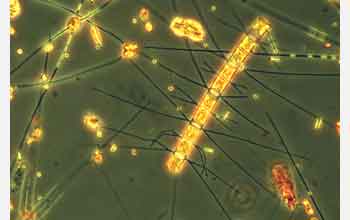Multimedia Gallery
Large-cell Diatom Algae (Image 2)
Large-cell diatom algae Chaetoceros sp., which are part of the annual phytoplankton spring bloom -- microscopic algae suspended in water -- in the Baltic sea. [See related image Here.]
More about this image
Diatoms, a form of phytoplankton, are an important part of the food chain in the sea. The larva of many species of saltwater fish feed on copepods (small planktonic crustaceans) and the copepods, in turn, feed on diatoms. Changes in climate could affect the seasonal cycles of these creatures, which could in turn affect the balance between predator and prey.
Ulrich Sommer, professor of biological oceanography at the Leibniz Institute of Marine Sciences at the University of Kiel, is studying whether increases in water temperature will significantly alter the time of the spring bloom. Experiments were conducted with indoor mesocosms filled with late-winter plankton from the Baltic Sea. Sommer found that increases in water temperature altered the time of the spring bloom only slightly -- about one day-per-degree centigrade. However, an increase in water temperature accelerated the hatching time of the nauplius larvae from over-wintering copepod eggs by about nine days-per-degree centigrade.
In the lab, the Chaetoceros sp. were dominant under cold conditions during experimentally induced spring blooms. But when the water temperature increased, the types of species that make up the spring bloom changed from large-cell diatom algae to small flagellates. This could potentially affect the food chain because the latter are rarely eaten by copepods.
If an increase in water temperature causes the period of maximum food supply and food demand for nauplius larvae to spread further apart, and the composition of species in the spring bloom becomes increasingly inadequate, this will alter the balance of the food chain, and could mean the nauplii would die of starvation and the fish larvae in turn would have nothing to eat.
For detailed study information refer to the following research papers:
-Sommer, U., Aberle, N., Engel, A., Hansen, T., Lengfellner, K., Sandow, M., Wohlers, J., Zöllner, E., and Riebesell, U. (2007) An indoor mesocosm system to study the effect of climate change on the late winter and spring succession of Baltic Sea phyto- and zooplankton. Oecologia 150: 655-667
-Sommer, U., Lengfellner, K. (2008) Climate change and the timing, magnitude and composition of the phytoplankton spring bloom. Global Change Biol. 14:1199-1208. (Date of Image: 2005)
Credit: Ulrich Sommer, IFM-GEOMAR Kiel
See other images like this on your iPhone or iPad download NSF Science Zone on the Apple App Store.
Images and other media in the National Science Foundation Multimedia Gallery are available for use in print and electronic material by NSF employees, members of the media, university staff, teachers and the general public. All media in the gallery are intended for personal, educational and nonprofit/non-commercial use only.
Images credited to the National Science Foundation, a federal agency, are in the public domain. The images were created by employees of the United States Government as part of their official duties or prepared by contractors as "works for hire" for NSF. You may freely use NSF-credited images and, at your discretion, credit NSF with a "Courtesy: National Science Foundation" notation.
Additional information about general usage can be found in Conditions.
Also Available:
Download the high-resolution JPG version of the image. (2.6 MB)
Use your mouse to right-click (Mac users may need to Ctrl-click) the link above and choose the option that will save the file or target to your computer.



